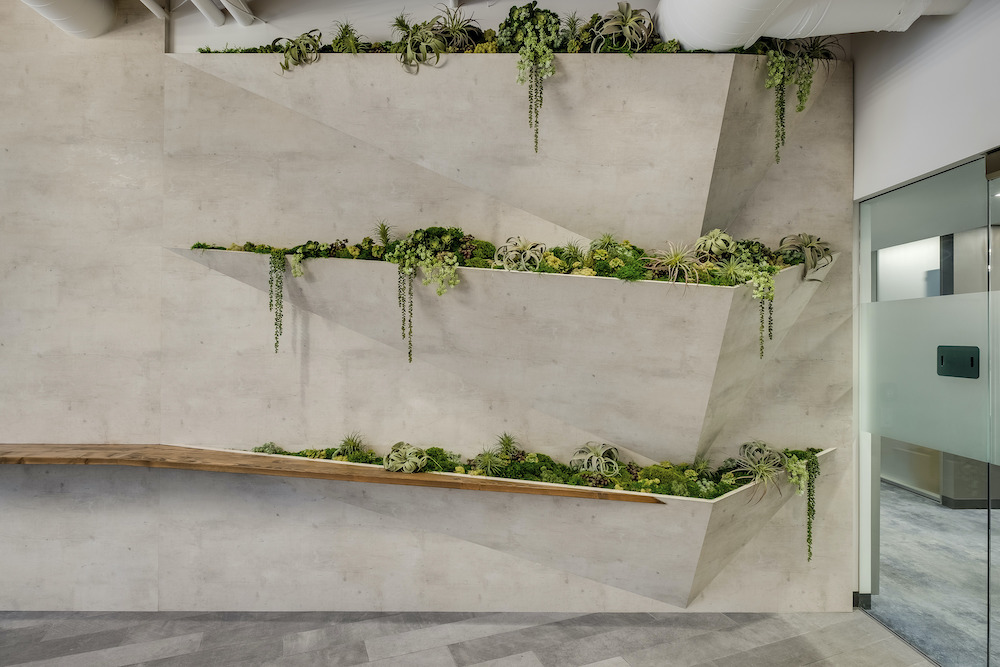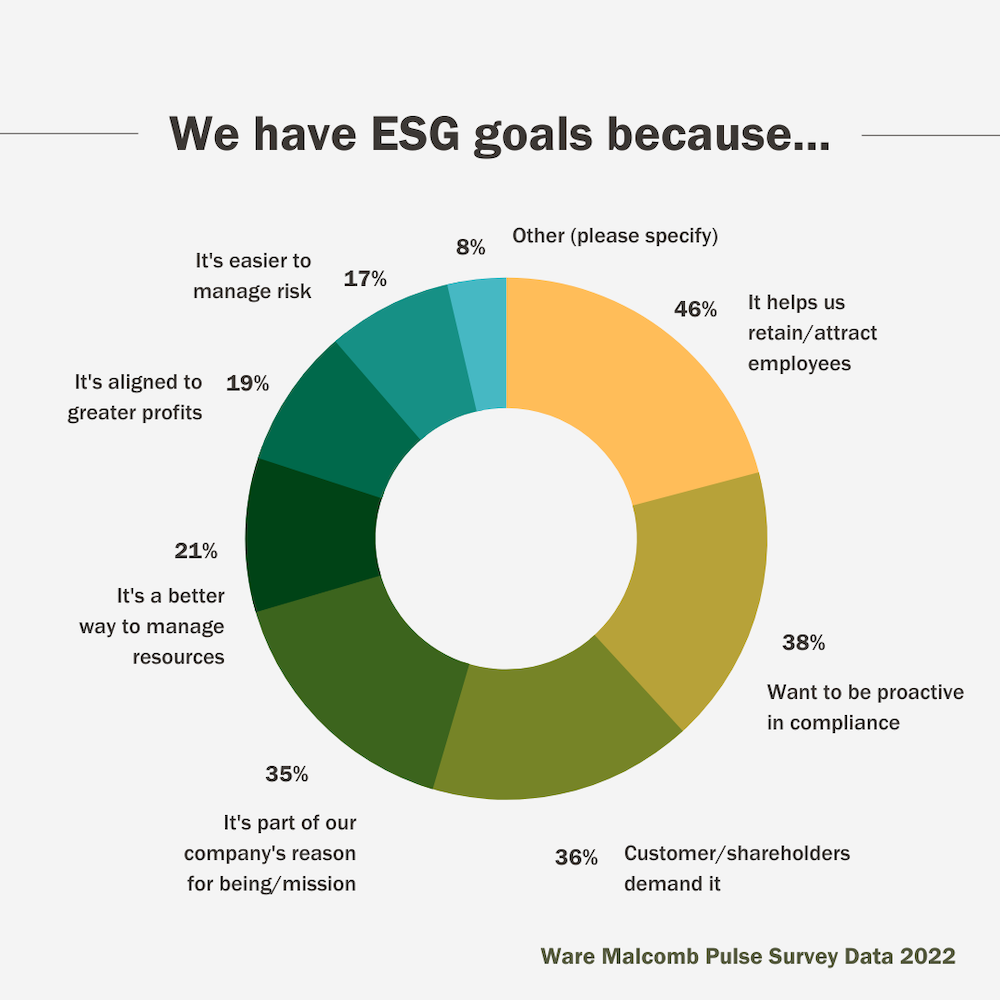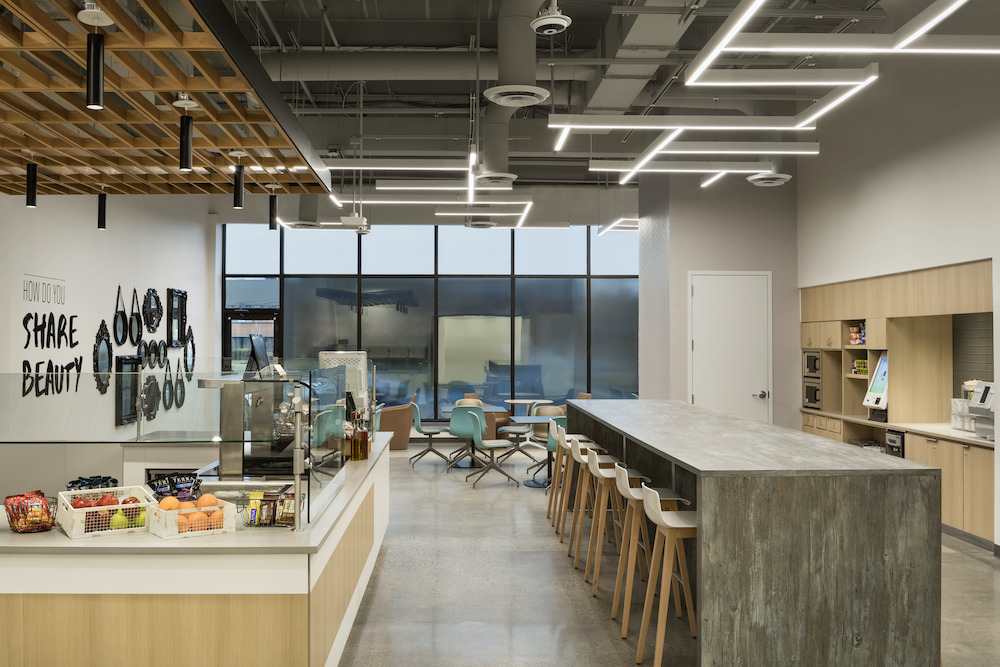Erica Godun of Ware Malcomb explores how ESG can have a broad, positive impact on our spaces as we expand design possibilities to include more than the physical space.

The focus on sustainability in the built environment has evolved over time. It started with a simple focus of minimizing negative construction impacts and expanded to an emphasis on occupants’ mental and physical health. Today, this conversation also includes social impacts on the community and corporate governance efforts. These varied considerations are often being bundled under the increasingly popular acronym “ESG”.
ESG, short for Environmental, Social and Governance, was originally related to the finance industry as a framework for assessing investment risk. This idea led investors to request ESG reporting metrics to provide data for their decision-making process on whether to invest. ESG reporting covers everything from vendor selection and diversification goals to improvements in internal operations – including people and places. That’s where the design world intersects with the data-driven world of ESG.
Recent data from our research program shows the top reason companies are pursuing ESG goals is to benefit their employees and help attract and retain talent. Furthermore, the data shows companies’ top goal for ESG programs is employee treatment.


So how do the concepts of environmental, social and governance influence how we design spaces?
We shouldn’t be looking at these as individual categories but as interwoven sources of inspiration. For example, we can design spaces to support their specific function, while incorporating aesthetics to enhance mental wellbeing, healthy materials to support physical health, and select products from socially responsible companies. Thoughtfully designed spaces reflect a company’s mission and support the culture.
The office needs to be a destination.
While companies are encouraging team members back to the office, many have settled on a hybrid work week. With hybrid as an accepted format, office design goals have expanded well beyond employee comfort to enticing them to be on site regularly with a plethora of amenities and perks. The office needs to be a destination. A place that offers a positive employee experience and supports the work/life balance many people found when working entirely from home. The office “fun factor” has extrapolated to include features like golf simulators, fitness centers, cafés with baristas, and revamped collaboration spaces with a focus on employee socialization, ideation and culture rather than heads down workstations we’ve known in the past.
To achieve a sustainable hybrid work model, the design of the physical space should be complimented by company policies. The policies in place must be employee-centric and garner trust within the organization. In 2023, it is predicted that measuring trust on the organizational, team and manager levels will be fundamental to establishing a sustainable hybrid work model.
To achieve a sustainable hybrid work model, the design of the physical space should be complimented by company policies.
A company may decide to provide healthy snacks or meals at the office to encourage better eating habits. This requires consideration of the pantry/kitchen design to accommodate a larger assortment of items than the typical layout. With unassigned seating providing maximum flexibility, the kitchen also becomes an amenity with an overflow seating area on busy office days. One of the Ware Malcomb leaders who recently made use of our own office’s pantry seating, commented that it was a productive day for connecting with staff as everyone stopped to chat when they popped in for coffee.

The technology that made it possible for 100% remote work must be integrated into the office environment so on-site employees can easily communicate with remote team members. Ware Malcomb has been asked to incorporate 2–3-person meeting rooms with screens into our projects to allow for small group video conferencing. To provide a seamless hybrid experience, the technology must be well equipped on both sides. Organizations may consider offering off-site set-ups or a stipend for staff to create their own workspace. Off-site accommodations may include the same ergonomic chairs and sit-stand desks available in office environments to maximize employee comfort. This supports employee physical health while working, regardless of location.
Buildings should be assets to their local communities – not empty shells at the end of the workday.
Buildings should be assets to their local communities – not empty shells at the end of the workday. Incorporating active public spaces into building lobbies or individual office spaces should be a consideration. Flex spaces can serve as gathering areas, art galleries or a holiday market for less fortunate local families with building tenants invited to volunteer or participate. Company programs can be developed to encourage staff to volunteer for these community activities and by tying the location to the office, it creates another reason to be present in-person.
Designing the modern office space requires considerations outside the specific location to attract and retain employees and align with corporate ESG goals. The concepts embedded in ESG can guide and support this process. ESG may have slipped into the design world lexicon from its roots in finance, but it can have a broad, positive impact on our spaces as we expand the design possibilities to include more than the physical space.

